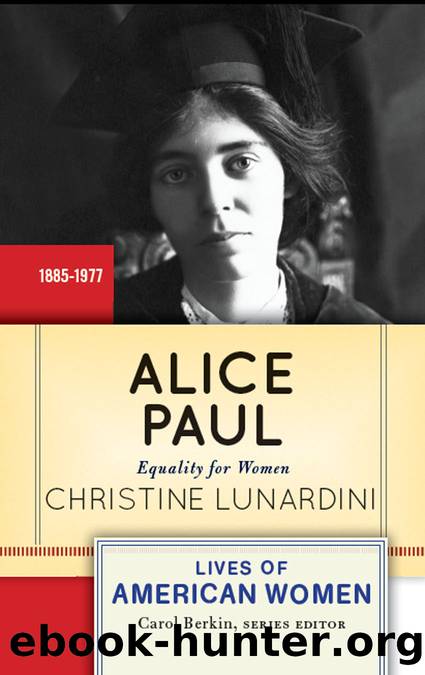Alice Paul: Equality for Women by Christine A. Lunardini

Author:Christine A. Lunardini [Lunardini, Christine A.]
Language: eng
Format: epub
Tags: Political Science, Biography, General, Feminism
ISBN: 9780813347622
Google: JR9WDwAAQBAJ
Goodreads: 17032499
Publisher: Westview Press
Published: 2012-11-06T00:00:00+00:00
7
The War Against Women
On January 10, 1917, Alice Paul launched the next phase of her well-thought-out campaign to secure a federal amendment. Following the antiâDemocratic Party campaign of 1916, Paul huddled with several of her lieutenants, including Lucy Burns, Harriot Stanton Blatch, Mabel Vernon, Mary Beard, and Dora Lewis. She proposed to start a picket line outside of the White House gates. The biggest problem she had to deal with before implementing the plan was ensuring there were enough volunteers to do the job properly. It would not do to begin a picketing campaign and watch it fizzle out for lack of volunteers. If that happened, the NWP would appear to have lost the momentum for support of a federal amendment. Initially, Paul wanted members of both the NWP and the CU to go on the picket line. But Blatch, whose New York organization had already picketed the state capital building in Albany, suggested that picketing ought to be something that was left to the unenfranchised women of the East. In other words, the NWP membership should continue to lobby in their states but picketing should be the contribution made by women who could not yet vote. Taking this step, Blatch believed, would provide a focus for women not yet sure of how they could personally participate in the cause. Blatchâs argument persuaded Paul. The decision was made that if there was to be a picketing campaign, volunteers would be sought from the CU membership. Paul chose Blatch to present the case for a picketing campaign to the National Executive Committee. âWe canât organize bigger and more influential deputations,â Blatch reasoned. âWe canât organize bigger processions. We canât, women, do anything more in that line. We have got to take a new departure.â1
No one disagreed with Blatchâs proposal regarding the makeup of the picket lines. But some women were ambivalent about undertaking a picketing campaign at all. Not only Paul but many NWP members had received complaints related to the antiâDemocratic Party campaigns waged in 1914 and 1916. And a number of pro-NAWSA suffragists, Democratic Party voters, and family members continued to express severe doubts about the wisdom of campaigning against Democratic politicians who favored woman suffrage. Then, too, a great many suffragists did not approve of what they considered a militant strategy. Under the circumstances, it was not at all certain that, if they initiated a picketing campaign, there would be sufficient support to carry it through as long as necessary. Even Paulâs mother asked Alice to reconsider her new tactic because it seemed so undignified. Fortunately for Paul, President Wilson himself tipped the scales in favor of the new campaign.
On January 9, 1917, three hundred women met with Wilson in order to present him with a resolution passed on Christmas Day 1916, at a memorial service for Inez Milholland. Inez had been a highly effective speaker on behalf of suffrage. She was able to draw crowds whenever her name appeared on the speakersâ list at rallies. Inez astride
Download
This site does not store any files on its server. We only index and link to content provided by other sites. Please contact the content providers to delete copyright contents if any and email us, we'll remove relevant links or contents immediately.
Fanny Burney by Claire Harman(26257)
Empire of the Sikhs by Patwant Singh(22775)
Out of India by Michael Foss(16695)
Leonardo da Vinci by Walter Isaacson(12817)
Small Great Things by Jodi Picoult(6694)
The Six Wives Of Henry VIII (WOMEN IN HISTORY) by Fraser Antonia(5244)
The Wind in My Hair by Masih Alinejad(4852)
The Crown by Robert Lacey(4579)
The Lonely City by Olivia Laing(4577)
A Higher Loyalty: Truth, Lies, and Leadership by James Comey(4566)
The Iron Duke by The Iron Duke(4127)
Millionaire: The Philanderer, Gambler, and Duelist Who Invented Modern Finance by Janet Gleeson(4117)
Papillon (English) by Henri Charrière(3924)
Sticky Fingers by Joe Hagan(3916)
Joan of Arc by Mary Gordon(3797)
Alive: The Story of the Andes Survivors by Piers Paul Read(3743)
Stalin by Stephen Kotkin(3731)
Aleister Crowley: The Biography by Tobias Churton(3435)
Ants Among Elephants by Sujatha Gidla(3282)
